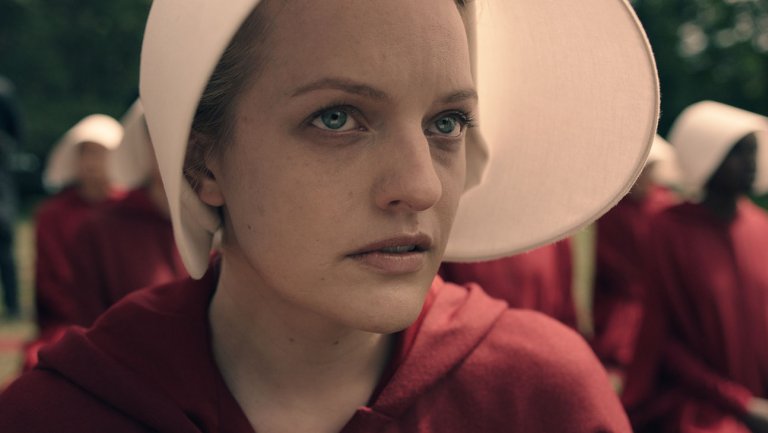Hulu’s “The Handmaid’s Tale”: TV Review
by Dan Feinberg
Hulu’s all-too-timely adaptation of Margaret Atwood’s novel is one of the spring’s best new shows and makes Elisabeth Moss an immediate Emmy contender.
Branching out from Nov. 8, 2016, is an alternate timeline in which The Handmaid’s Tale could simply be enjoyed as a beautifully produced speculative thriller, a cautionary tale worthy of praise particularly for Elisabeth Moss’ lead performance and for perhaps being Hulu’s first essential original.
Many involved in this adaptation of Margaret Atwood’s revered dystopian novel might prefer that the series just play as wildly imaginative genre fare instead of as an urgent and all-too-timely warning about a world in which religious zealotry and despotic forces combine to control female reproductive health and disenfranchise women.
It’s an urgency and uncomfortable resonance that has only grown between the time I watched the premiere in January and then the second and third episodes ahead of the show’s April 26 premiere.
Adapted by Bruce Miller and executive produced by Warren Littlefield, The Handmaid’s Tale is set in a chilly near-future in what was once Boston, now patrolled by the armed guards of the fundamentalist dictatorship of Gilead. Due to widespread infertility, the few women capable of giving birth have been enslaved as “handmaids,” conscripted to couples of stature and forced into ritualized intercourse and child-bearing.
Offred (Moss) is a handmaid to the Commander (Joseph Fiennes). She’s viewed with contempt by the Commander’s wife (Yvonne Strahovski) and pity by his other staff, including driver Nick (Max Minghella). Offred remembers the way the world used to be, including a husband and daughter and a spirited college chum, Moira (Samira Wiley). Now, because of the torturous training Offred is made to suffer under the thumb of Aunt Lydia (Ann Dowd), we hear her innermost thoughts only via voiceover. Conversation instigated by handmaid shopping companion Ofglen (Alexis Bledel) leads Offred to contemplate a future beyond indentured baby-making, but such thoughts can bring hope — and hope can be dangerous.
I’m not sure that I would have immediately thought of Miller as the most likely shepherd for this project, but in retrospect his background on The 100 points to an ability to deliver science fiction with a feminist twist. Your perspective will determine if The Handmaid’s Tale is a taut, arty drama or if it offers footnotes for a revolution.
The world Miller builds on Atwood’s sturdy thematic platform is one of quasi-religious mantras, barbaric twists of justice and perverse loss of humanity. Disconcertingly, the more concretely Miller represents the cultural stratification, the twisted remnants of government and the grotesque subversion of what we consider private and sacred — the mock births with the barren wives, the blending of polyamory and cuckolding, casual discussions of a handmaid’s menstrual cycle — the more realistic The Handmaid’s Tale feels. The nightmarish third episode shows the last moments of the collapsing old world, in which the unfathomable is realized, and the discourse we hear is indistinguishable from conversations currently being had by all-male state legislatures on abortion rights.
The blend of breathless terror is highlighted by Reed Morano, who directed all three episodes sent to critics. A former cinematographer, Reed has an impeccable eye that yields compositions of bracing precision. She rations out reds for the robes of the handmaids. She saves chilly blues for the wives. As much as possible, light comes only from direct sources and shafts of sunlight crash through murky scenes like unauthorized interlopers. Shooting Toronto-for-Boston lets Morano create a space that doesn’t quite correspond with any city we know. It’s familiar, but alien, just like the puritanical attire of the handmaids, whose bonnets and cloaks make them resemble invaders from another time. Depending on the moment, you might spot the influence of a Kubrick, Cuarón or Campion, but this is as original and confidently directed a set of early episodes as I’ve seen in years. Technical kudos are also due to costume designer Ane Crabtree, production designer Julie Berghoff and cinematographer Colin Watkinson.
Appearing in nearly every scene, Moss is Morano’s worthy co-conspirator. With The West Wing, Mad Men and Top of the Lake, the actress has built one of the great résumés of the Peak TV Era, lacking only an Emmy for final validation. That drought should end here. Offred has moments in which she practically blends into the wallpaper, almost a chameleon trying not to be noticed. But Moss also gives glimpses of feral intensity and fiercely guarded intelligence. Best of all, sometimes only in her narration, Moss injects the finest threads of humor, exactly the humanizing nuance the show needs to avoid falling too much into coldness or darkness. I’d say the second and third episodes could possibly benefit from even more of those exhalations of levity, but just as well not to force it.
As great as Moss is, evoking pity and empathy and inspiration, she’s surrounded by an ensemble of peers. Bledel’s occasionally affectless line deliveries are used to deceptive effect, masking what becomes her best and most moving performance to date. Also getting better with each episode is Strahovski, giving her characters a Rorschach-test range of motivations. Dowd and Wiley shine as opposites, the former a stern enforcer of repression, the latter a fiery beacon of outrage. If Fiennes and Minghella are bland and unreadable, it’s because this isn’t their story and they’re intended to be.
Atwood’s novel proved an adaptation challenge in the past, and some purists will likely quibble with some of the things Miller has chosen to spell out or literalize. And caution may grow if Hulu pushes The Handmaid’s Tale beyond the narrative of the book. Regretfully, the 30-plus-year-old work has become a story for the very time and place we’re living in; this is probably the spring’s best new show and certainly its most important.

